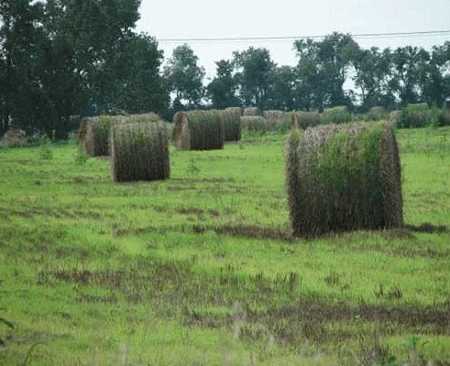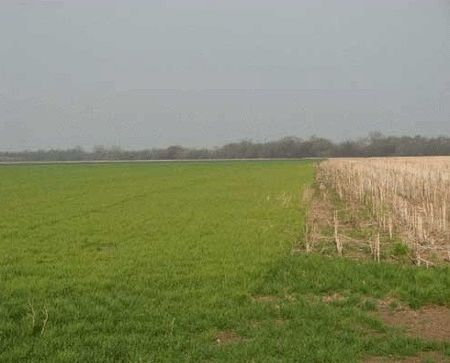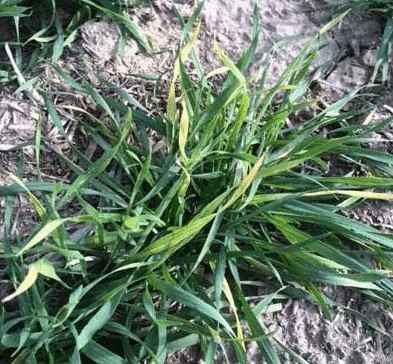By Erick DeWolf and Kelsey Andersen Onofre
In some years, wheat streak mosaic virus (WSMV) can be a severe problem for Kansas wheat producers. Fields with very severe wheat streak mosaic can typically be traced back to a lack of control of volunteer wheat. Problems with wheat production the previous year can leave large amounts of seed on the soil surface. As this seed germinates, it creates a “green bridge”, allowing wheat streak mosaic and wheat curl mites to survive locally.
Challenges faced in 2020
This year, the wheat crop faced several challenges that might have increased the amount of seed left behind after harvest, which could also increase the amount of volunteer wheat (Figure 1). These problems included:
- Freeze damage during stem elongation (which caused many delayed wheat heads to emerge)
- Hailed out wheat
- Some reports of head scab (Fusarium head blight)
- Waterlogging conditions in parts of central Kansas
- Drought-stressed wheat
The presence of later-emerged heads due to the freeze damage to main stems can cause differences in maturity between tillers that survived the freeze and later tillers, which can increase harvest losses. One of the recommendations to manage fields affected by head scab is to increase the fan speed of the combine and “blow” the diseased kernels out of the harvested grain. Likewise, waterlogged conditions and drought stress both decrease wheat kernel weight and likely increase harvest losses of grain. These smaller kernels might germinate into volunteer wheat increasing the risk of severe wheat streak mosaic the following year.

Figure 1. Thick stand of volunteer wheat after wheat harvest. Photo by Stu Duncan, K-State Research and Extension.
Wheat curl mites will move off growing wheat as the green tissue dries down and dies. After moving off the existing wheat at or near harvest time, the mites need to find green tissue of a suitable host soon or they will die of desiccation.
Producers often like to wait several weeks after harvest before making their first herbicide application to control volunteer wheat. This allows as much volunteer as possible to emerge before spraying it or tilling it the first time. Often, a second application or tillage operation will be needed later in the summer to eliminate the green bridge to fall-planted wheat by making sure all volunteer is dead within ½ mile of wheat being planted in the fall. Wet weather through late summer often favors multiple flushes of volunteer wheat and also favors the growth of other grassy weeds that can also support moderate populations of the curl mites and virus. These weather patterns keep a lot more alternate host plants alive during the critical period when mites and virus would not have plants to survive on.
If volunteer has emerged and is still alive shortly after harvest in hailed-out wheat, wheat curl mites could easily build up rapidly and spread to other volunteer wheat that emerges later in the season. On the other hand, if this early-emerging volunteer is controlled shortly after harvest, that will help greatly in breaking the green bridge. However, if more volunteer emerges during the summer, follow-up control will still be needed.
Other hosts for the wheat curl mite
Volunteer wheat is not the only host of the wheat curl mite. Over the years, multiple research studies have evaluated the suitability of wild grasses as hosts for both the curl mite and the wheat streak virus. There is considerable range in the ability of a grassy weed species to host the mite and the virus. Barnyardgrass is among the more suitable hosts for both virus and mites, but fortunately it is not that common in wheat fields. In contrast, various foxtails, although a rather poor host, could be an important disease reservoir simply because of their abundance. These grasses may play an important role in allowing the mites and virus to survive during the summer months particularly in the absence of volunteer wheat.
The K-State Research and Extension publication, MF3383 - Wheat Streak Mosaic, includes information about grassy weed hosts of the mite and virus, and the contribution of these hosts to the risk of severe wheat streak mosaic infections. Take note of significant stands of these grasses in marginal areas and control them as you would volunteer wheat.
If volunteer wheat and other hosts are not controlled throughout the summer and are infested with wheat curl mites, the mites will survive until fall and could infest newly planted wheat. Wheat curl mite infestations of wheat often lead to wheat streak mosaic infections (Figures 2 and 3).

Figure 2. Volunteer wheat on the edges of a sunflower field were infested with wheat curl mites and caused a wheat streak mosaic infection in the adjacent wheat crop that fall. Photo by Stu Duncan, K-State Research and Extension.

Figure 3. Close-up of wheat showing symptoms of a wheat streak mosaic virus infection in the fall. Photo by Jeanne Falk Jones, K-State Research and Extension.
Genetic resistance to wheat streak mosaic can also reduce the risk of severe disease problems. There are currently a few varieties adapted to Kansas that have wheat streak mosaic resistance, including KS Dallas (red), Guardian (red), Oakley CL (red), Joe (white), and Clara CL. All of these varieties have the same resistance source (WSM2). This resistance helps, but does have some serious limitations. For example, this resistance is effective against wheat streak mosaic but does not cover triticum mosaic or high plains (two other viral diseases also spread by the wheat curl mites). The resistance conferred by WSM2 is also temperature sensitive and is much less effective at high temperatures, although the resistance in KS Dallas seem to endure greater temperatures before breaking down. If wheat is planted early for grazing or if high temperatures persist into October, the resistance is much less effective. KS Silverado (white) also has temperature sensitive resistance to wheat streak mosaic, although from a different source other than WSM2.
In addition, there are a handful of varieties with resistance to the wheat curl mite, including TAM 112, Byrd, Avery, Langin, KS Western Star, Whistler, Canvas, Guardian, Crescent AX, Incline AX, Fortify SF, TAM 115, TAM 204, and T158. These varieties are actually susceptible to the viral diseases, but they generally slow the development of the mite populations in the fall. This resistance can help reduce the risk of severe disease but will not provide enough protection if wheat is planted in close proximity to volunteer wheat or other hosts infested with large populations of the curl mites and virus.
Source : ksu.edu